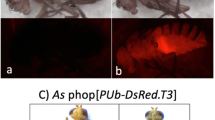Abstract
A new hopper element belonging to the hAT transposon family was isolated from the white eye mutant strain of the Oriental fruit fly, Bactrocera dorsalis. Using the original hopper element sequence from the wild type Kahuku strain as a template, the new hopper was isolated by inverse and direct PCR. Nucleotide sequence analysis reveals a 3131 bp element with terminal and subterminal inverted repeat sequences, an 8 bp duplicated insertion site, and a conceptual translation yielding a single uninterrupted 650 amino acid open reading frame. The white eye hopper has structure more consistent with function than the Kahuku element, indicating that hopper is not an ancient relic. The hopper element remains distantly related to other known hAT elements including those from insects, and presently it is most similar to Activator-related elements discovered in the human genome. DNA hybridization studies indicate, however, that elements closely related to hopper exist in another bactrocerid species, the melonfly, B. cucurbitae.
Similar content being viewed by others
References
Altschul, S.F., T.L. Madden, A.A. Schäffer, J. Zhang, Z. Zhang, W. Miller & D.J. Lipman, 1997. Gapped BLAST and PSI-BLAST: a new generation of protein database search programs. Nucl. Acids Res. 25: 3389–3402.
Aravind, L., 2000. The BED finger, a novel DNA-binding domain in chromatin-boundary-element-binding proteins and transposases. Trends Biochem. Sci. 25: 421–423.
Becker, H.A. & R. Kunze, 1997. Maize activator transposase has a bipartite DNA binding domain that recognizes subterminal sequences and the terminal inverted repeats. Mol. Gen. Genet. 254: 219–230.
Calvi, B.R., T.J. Hong, S.D. Findley & W.M. Gelbart, 1991. Evidence for a common evolutionary origin of inverted repeat transposons in Drosophila and Plants: hobo, Activator, and Tam3. Cell 66: 465–471.
Coates, C.J., N.K. Johnson, H.D. Perkins, A.J. Howells & D.A. O'Brochta, 1996. The hermit transposable element of the Australian sheep blowfly, Lucilia cuprina, belongs to the hAT family of transposable elements. Genetica 97: 23–31.
DeVault, J.D. & S.K. Narang, 1994. Transposable elements in Lepidoptera: hobo-like transposons in Heliothis virescens and Heliocoverpa zea. Biochem. Biophys. Res. Comm. 203: 169–175.
Esposito, T., F. Gianfrancesco, A. Ciccodicola, L. Montanini, S. Mumm, M. D'Urso & A. Forabosco, 1999. A novel pseudoautosomal human gene encodes a putative protein similar to Ac-like transposases. Hum. Mol. Genet. 8: 61–67.
Essers, L., R.H. Adolphs & R. Kunze, 2000. A highly conserved domain of the maize activator transposase is involved in dimerization. Plant Cell. 12: 211–224.
Feldmar, S. & R. Kunze, 1991. The ORFa protein, the putative transposase of maize transposable element Ac, has a basic DNA binding domain. EMBO J. 10: 4003–4010.
Handler, A.M. & S.P. Gomez, 1996. The hobo transposable element excises and has related elements in tephritid species. Genetics 143: 1339–1347.
Handler, A.M. & S.P. Gomez, 1997. A new hobo, Activator, Tam3 transposable element, hopper, from Bactrocera dorsalis is distantly related to hobo and Ac. Gene 185: 133–135.
Higgins, D.G., A.J. Bleasby & R. Fuchs, 1992. CLUSTAL V: improved software for multiple sequence alignment. Comput. Appl. Biosci. 8: 189–191.
Kempken, F. & F. Windhofer, 2001. The hAT family: a versatile transposon group common to plants, fungi, animals, and man. Chromosoma 110: 1–9.
McCombs, S.D. & S.H. Saul, 1992. Linkage analysis of five new genetic markers of the oriental fruit fly, Bactrocera dorsalis (Diptera: Tephritidae). J. Heredity 83: 199–203.
McCombs, S.D., D.O. McInnis & S.H. Saul, 1995. Genetic studies of the melon fly, Bactrocera cucurbitae (Diptera: Tephritidae). In Fruit Fly Pests A World Assessment of their Biology and Mangaemnet, edited by B.A. McPheron & G.S. Steck. St. Lucie Press, Clearwater, FL.
Pinkerton, A.C., S. Whyard, H.A. Mende, C.J. Coates, D.A. O'Brochta & P.W. Atkinson, 1999. The Queensland fruit fly, Bactrocera tryoni, contains multiple members of the hAT family of transposable elements. Insect Mol. Biol. 8: 423–434.
Robertson, H.M. & D.J. Lampe, 1995. Distribution of transposable elements in arthropods. Annu. Rev. Entomol. 40: 333–357.
Rubin, E., G. Lithwick & A.A. Levy, 2001. Structure and evolution of the hAT transposon superfamily. Genetics 158: 949–957.
Swofford, D.L., 1993. PAUP: Phylogenetic Analysis Using Parsimony, Version 3.1.1. Smithsonian Institute, Washington, DC.
Thompson, J.D., D.G. Higgins & T.J. Gibson, 1994. CLUSTAL W: improving the sensitivity of progressive multiple sequence alignment through sequence weighting, position-specific gap penalties and weight matrix choice. Nucl. Acids Res. 22: 4673–4680.
Warren, W.D., P.W. Atkinson & D.A. O'Brochta, 1994. The Hermes transposable element from the house fly, Musca domestica, is a short inverted repeat-type element of the hobo, Ac, and Tam3 (hAT) element family. Genet. Res. Camb. 64: 87–97.
Warren, W.D., P.W. Atkinson & D.A. O'Brochta, 1995. The Australian bushfly Musca vetustissima contains a sequence related to transposons of the hobo, Ac, and Tam3 family. Gene 154: 133–134.
Author information
Authors and Affiliations
Corresponding author
Rights and permissions
About this article
Cite this article
Handler, A.M. Isolation and Analysis of a New hopper hAT Transposon from the Bactrocera Dorsalis White Eye Strain. Genetica 118, 17–24 (2003). https://doi.org/10.1023/A:1022944120410
Issue Date:
DOI: https://doi.org/10.1023/A:1022944120410




